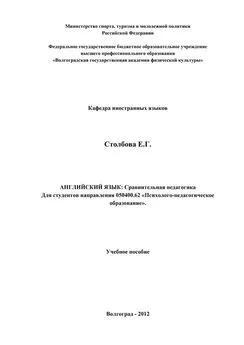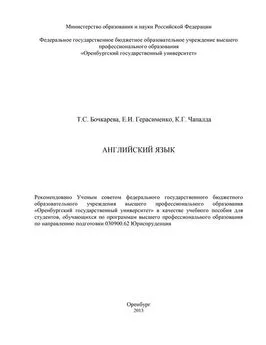Елена Беликова - Английский язык
- Название:Английский язык
- Автор:
- Жанр:
- Издательство:неизвестно
- Год:неизвестен
- ISBN:нет данных
- Рейтинг:
- Избранное:Добавить в избранное
-
Отзывы:
-
Ваша оценка:
Елена Беликова - Английский язык краткое содержание
Студенту без шпаргалки никуда! Удобное и красивое оформление, ответы на все экзаменационные вопросы ведущих вузов России.
Английский язык - читать онлайн бесплатно ознакомительный отрывок
Интервал:
Закладка:
lining – выравнивание
entire – весь
vas cular – сосудистый
underlying – лежащий в основе
basal – основной
lamina – тонкая пластинка
25. Veins
Veins are low-pressure vessels that have larger lumina and thinner walls than arteries. In general, veins have more collagenous connec tive tissue and less muscle and elastic tissue than their arterial coun terparts. Although the walls of veins usually exhibit the three layers, they are much less distinct than those of the arter ies. Unlike arteries, veins contain one-way valves composed of exten sions of the intima that prevent reflux of blood away from the heart. Veins can be divided into small veins or venules, medium veins, and large veins.
Venules are the smallest veins, ranging in diameter from approxi mately 15–20 mm (post-capillary venules) up to 1–2 mm (small veins). The walls of the smaller of these are structurally and func tionally like those of the capillaries; they consist of an endothelium surrounded by delicate collagen fibers and some pericytes. In those vessels of increased diameter, circularly arranged smooth muscle cells occur surrounding the intima layer, but unlike in the small arteries, these cells are loosely woven and widely spaced. Venules are important in inflammation because their endothelial cells are sensitive to hista-mine released by local mast cells. This causes endotheli-al cells to contract and separate from each other, exposing a naked basement membrane. Neutrophils stick to the exposed collagen and extravasate (i. e., move out into the connective tissue). Histamine also causes local arterioles to relax, affect ing a rise in venous pressure and increased leaking of fluid. This produces the classic signs of inflammation: redness, heat, and swelling.
Medium veins in the range of 1–9 mm in diameter have a well – developed intima, a media consisting of connective tissue and loosely organized smooth muscle, and an adventitia (usually the thickest layer) composed of collagen bundles, elastic fibers, and smooth muscle cells oriented along the longitudinal axis of the vessel. Venous valves are sheet-like outfoldings of endothelium and underlying connective tissue that form flaps to permit uni-di rectional flow of blood.
Large veins, such as the external iliac, hepatic portal, and vena cavae, are the major conduits of return toward the heart. The intima is similar to that of medium veins. Although a network of elastic fibers may occur at the boundary between the intima andmedia, a typical internal elastic membrane as seen in arteries is not present. A tunica media may or may not be present. If pre sent, smooth muscle cells are most often circularly arranged. The ad-ventitia is the thickest layer of the wall and consists of elastic fibers and longitudinal bundles of collagen. In the vena cava, this layer also contains well-developed bundles of longitudinally oriented smooth muscle.
vein – вена
low-pressure – низкое давление
collagenous – коллагеновый
intima – интима
reflux – рефлюкс
inflammation – воспаление
longitudinal – продольный
flaps – створки
iliac – подвздошный
hepatic – печеночный
26. Heart
Intrapulmonary bronchi: the primary bronchi give rise to three main branches in the right lung and two branches in the left lung, each of which supply a pulmonary lobe. These lobar bronchi divide repeatedly to give rise to bronchioles.
Mucosa consists of the typical respiratory epithelium.
Submucosa consists of elastic tissue with fewer mixed glands than seen in the trachea.
Anastomosing cartilage plates replace the C-shaped rings found in the trachea and extra pulmonary portions of the pri mary bronchi.
Bronchioles do not possess cartilage, glands, or lymphatic nodules; however, they contain the highest proportion of smooth r muscle in the bronchial tree. Bronchioles branch up to 12 times to supply lobules in the lung.
Bronchioles are lined by ciliated, simple, columnar epithelium with nonciliated bronchiolar cells. The musculature of the bronchi and bronchioles con tracts following stimulation by parasympathetic fibers (vagus nerve) and relaxes in response to sympathetic fibers. Terminal bronchioles consist of low-ciliated epithelium with bronchiolar cells.
The costal surface is a large convex area related to the inner surface of the ribs.
The mediastinal surface is a concave medial surface, contains the root, or hilus, of the lung.
The diaphragmatic surface (base) is related to the convex sur face of the diaphragm. The apex (cupola) protrudes into the root of the neck.
The hilus is the point of attachment for the root of the lung. It contains the bronchi, pulmonary and bronchial vessels, lym phatics, and nerves. Lobes and fissures ventricular con traction (systole). Semilunar valves (aortic and pulmonic) prevent reflux of blood back into the ventricles during ventricular relaxation (diastole). Impulse conducting system of the heart consists of specialized cardiac myocytes that are characterized by auto-maticity and rhythmicity (i. e., they are independent of nervous stimulation and possess the ability to initiate heart beats). These specialized cells are located in the sino-atrial (SA) node (pacemaker), intern-odal tracts, atrioven-tricular (AV) node, AV bundle (of His), left and right bundle branches, and numerous smaller branches to the left and right ventricular walls. Impulse conduct ing myocytes are in electrical contact with each other and with normal contractile myocytes via communicating (gap) junctions. Specialized wide-diameter impulse conducting cells (Purkinje myocytes), with greatly reduced myofilament components, are well-adapted to increase conduction velocity. They rapidly deliver the wave of depolarization to ventricular myocytes.
heart – сердце
muscular – мышечный
cardiac – сердечный
to pump – качать
endocardium – эндокардиум
innermost – самый внутренний
conducting system – проведение системы
subendocardial – внутрисердечный
impulse – импульс
fibrosi – фиброзные кольца
27. Lungs
Intrapulmonary bronchi: the primary bronchi give rise to three main branches in the right lung and two branches in the left lung, each of which supply a pulmonary lobe. These lobar bronchi divide repeatedly to give rise to bronchioles.
Mucosa consists of the typical respiratory epithelium.
Submucosa consists of elastic tissue with fewer mixed glands than seen in the trachea.
Anastomosing cartilage plates replace the C-shaped rings found in the trachea and extra pulmonary portions of the pri тагу bronchi.
Bronchioles do not possess cartilage, glands, or lymphatic nodules; however, they contain the highest proportion of smooth r muscle in the bronchial tree. Bronchioles branch up to 12 times to supply lobules in the lung.
Bronchioles are lined by ciliated, simple, columnar epithelium with nonciliated bronchiolar cells. The musculature of the bronchi and bronchioles con tracts following stimulation by parasympathetic fibers (vagus nerve) and relaxes in response to sympathetic fibers. Terminal bronchioles consist of low-ciliated epithelium with bronchiolar cells.
The costal surface is a large convex area related to the inner surface of the ribs.
The mediastinal surface is a concave medial surface, contains the root, or hilus, of the lung.
The diaphragmatic surface (base) is related to the convex sur face of the diaphragm. The apex (cupola) protrudes into the root of the neck.
The hilus is the point of attachment for the root of the lung. It contains the bronchi, pulmonary and bronchial vessels, lym phatics, and nerves. Lobes and fissures.
The right lung has three lobes: superior, middle and inferior.
The left lung has upper and lower lobes.
Bronchopulmonary segments of the lung are supplied by the segmental (tertiary) bronchus, artery, and vein. There are 10 on the right and 8 on the left.
Arterial supply: Right and left pulmonary arteries arise from the pulmonary trunk. The pulmonary arteries deliver deoxygenated blood to the lungs from the right side of the heart.
Bronchial arteries supply the bronchi and nonrespiratory por tions of the lung. They are usually branches of the thoracic aorta.
Venous drainage. There are four pulmonary veins: superior right and left and inferior right and left. Pulmonary veins carry oxygenated blood to the left atrium of the heart.
The bronchial veins drain to the azygos system.
Bronchomediastinal lymph trunks drain to the right lymphatic duct and the thoracic duct.
Innervation of Lungs: Anterior and posterior pulmonary plexuses are formed by vagal (parasympathetic) and sympathetic fibers. Parasympathetic stimulation has a bronchoconstrictive effect. Sympathetic stimulation has a bronchodilator effect.
lungs – легкие
intrapulmonary bronchi – внутрилегочные бронхи
the primary bronchi – первичные бронхи
lobar bronchi – долевые бронхи
submucosa – подслизистая оболочка
28. Respiratory system
The respiratory system is structurally and functionally adapt ed for the efficient transfer of gases between the ambient air and the bloodstream as well as between the bloodstream and the tissues. The major functional components of the res piratory system are: the airways, alveoli, and bloodvessels of the lungs; the tissues of the chest wall and diaphragm; the systemic blood vessels; red blood cells and plasma; and respi ratory control neurons in the brainstem and their sensory and motor connections. LUNG FUNCTION: provision of 02 for tissue metabolism occurs via four mechanisms. Ventilation – the transport of air from the environment to the gas exchange surface in the alveoli. 02 diffusion from the alveolar air space across the alveolar-capillary membranes to the blood.
Transport of 02 by the blood to the tissues: 02 diffusion from the blood to the tissues.
Removal of C02 produced by tissue metabolism occurs via four mechanisms. C02 diffusion from the tissues to the blood.
Transport by the blood to the pulmonary capillary-alveolar membrane.
C02 diffusion across the capillary-alveolar membrane to the air spaces of the alveoli. Ventilation – the transport of alveolar gas to the air. Functional components: Conducting airways (conducting zone; anatomical dead space).
These airways are concerned only with the transport of gas, not with gas exchange with the blood.
They are thick-walled, branching, cylindrical structures with ciliated epithelial cells, goblet cells, smooth muscle cells. Clara cells, mucous glands, and (sometimes) cartilage.
Alveoli and alveolar septa (respiratory zone; lung parenchyma).
These are the sites of gas exchange.
Cell types include: Type I and II epithelial cells, alveolar macrophages.
The blood-gas barrier (pulmonary capillary-alveolar membrane) is ideal for gas exchange because it is very thin (‹ 0,5 mm) and has a very large surface area (50 – 100 m 2). It consists of alveolar epithelium, basement membrane interstitium, and capillary endothelium.
respiratory – дыхательный
Читать дальшеИнтервал:
Закладка:










